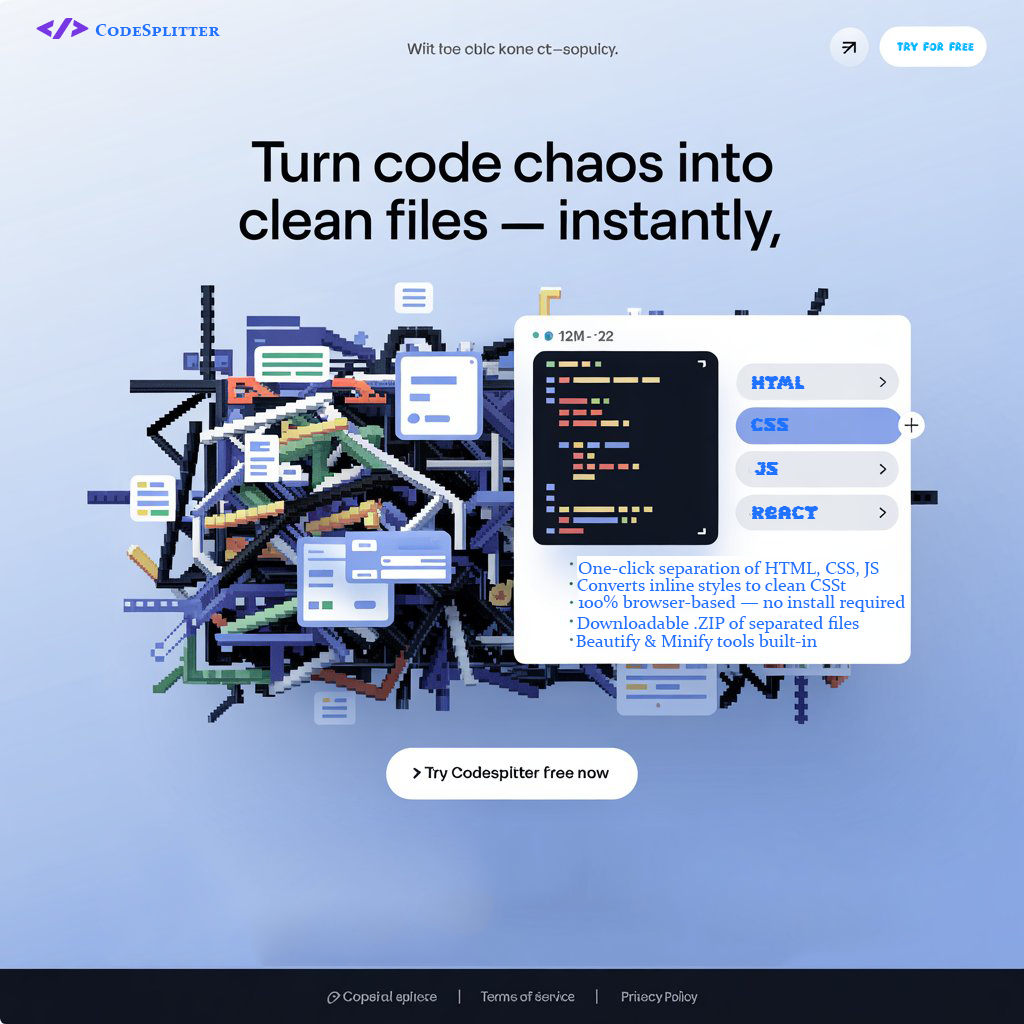PixelFree Studio
Alternatives
0 PH launches analyzed!

PixelFree Studio
From Design-to-Code in just 1 Click 🎉
853
Problem
Designers and developers often struggle to efficiently convert their visual designs into code, facing issues with time-consuming manual coding, potential for human error, and the incompatibility between design tools and coding environments. The time-consuming manual coding, potential for human error, and incompatibility between design tools and coding environments are significant drawbacks.
Solution
PixelFree Studio is a tool that allows users to convert their designs into human-readable PRO-code in seconds, with support for designs made in PixelFree Studio or Figma. With just one click, users can auto-generate their front-end without the need for frameworks or libraries and host it anywhere. The conversion of designs into human-readable PRO-code in seconds and the one-click auto-generation of front-end are its core features.
Customers
Web designers, front-end developers, and product managers who use design tools like Figma or PixelFree Studio for web and app development projects are most likely to use this product.
Unique Features
The ability to directly convert designs from Figma and PixelFree Studio into human-readable PRO-code without relying on any frameworks or libraries, ensuring a seamless transition from design to code.
User Comments
Unfortunately, without data from actual users, it's challenging to summarize their opinions.
Traction
Given the properties of this question, specific traction data such as version releases, user numbers, and revenues couldn't be provided.
Market Size
The global market for tools bridging design and code, like PixelFree Studio, is estimated to grow significantly, as the demand for efficient web and app development solutions increases. However, specific data on market size isn't provided, making it challenging to give a precise figure.

Locofy Lightning
Figma Design to Code in 1-click, with Large Design Models
1213
Problem
Designers and developers often struggle with converting Figma designs into frontend code, which can be time-consuming and prone to inaccuracies. This process typically requires manual coding, which can lead to inconsistencies in design implementation and delays in project timelines.
Solution
Locofy Lightning is a tool that converts Figma designs to frontend code in 1-click, leveraging LocoAI's Large Design Models (LDMs). Users can obtain responsive, interactive designs and reusable code components with better class names, and easily sync code to GitHub, or pull into VS Code.
Customers
The product is primarily targeted at front-end developers, UI/UX designers, and web development agencies that regularly work with Figma designs and are looking for efficient ways to implement these designs into live websites or applications.
Unique Features
The unique selling point of Locofy Lightning is its ability to instantly convert complex Figma designs into accurate, interactive frontend code using AI-powered Large Design Models (LDMs), and its seamless integration with development tools like GitHub and VS Code.
User Comments
Currently, no user comments are available to provide insight into the public opinion of the product.
Traction
Detailed traction information, such as the number of users, revenue, or any financing activities, is not available based on the given information.
Market Size
The market size specific to Figma design to code conversion tools is not readily available. However, considering the broader market of front-end development tools, which was valued at approximately $8.2 billion in 2021, there's significant potential for growth and adoption within this niche.
Problem
Designers or publishers without coding skills struggle to create seamless UI components for their projects
Solution
An online tool called Code Generator, CODE SPIT, that allows users to create essential UI components for free with just a few clicks
Customers
Designers or publishers without coding skills
Alternatives
View all CODE SPIT alternatives →
Unique Features
Free code generator for essential UI components
User Comments
Easy to use, saves a lot of time for non-developers
Great tool for prototyping and designing
Traction
Information about traction not available
Market Size
The global market for design tools and software was valued at $52.27 billion in 2020.

VidEmpire : 1 Click YouTube Automation
1 Click YouTube Automation Software
5
Problem
Users manually create YouTube videos, which is time-consuming and resource-intensive. Manually create YouTube videos
Solution
YouTube automation tool enabling users to generate unlimited AI-based videos with one click. generate unlimited AI-based videos with one click
Customers
YouTubers, content creators, and digital marketers needing scalable video production.
Unique Features
1-click automation for both short/long videos, cheapest cost per video guarantee.
User Comments
Saves time on video creation
Affordable for bulk content
Simplifies YouTube automation
AI-generated content lacks uniqueness occasionally
User-friendly interface
Traction
1.2k+ ProductHunt upvotes, launched 2023, $29/month for unlimited videos
Market Size
Global online video creation market projected to reach $10 billion by 2027

AI-Powered Figma to Code
Use AI to convert Figma designs into clean, responsive code
213
Problem
Designers and developers often waste significant time converting Figma designs into functional code, leading to inefficiencies in the design-to-code workflow.
Solution
An AI-powered tool that converts Figma designs into clean, responsive code automatically, saving time and effort without the need to manually adjust design files.
Customers
Web designers, Front-end developers, UI/UX designers, and software development teams seeking to streamline their design-to-code processes.
Unique Features
Specialized AI model trained for high-quality code generation from Figma files.
User Comments
Significantly reduces development time
Increases productivity for design and development teams
Eases collaboration between designers and developers
Produces clean and responsive code
Simplifies the design-to-code workflow
Traction
Due to constraints, specific traction details such as number of users or MRR are not available. However, interest shown on product hunt and user comments suggest positive reception and growing user base.
Market Size
Global design-to-code software market is estimated to be worth billions, with an increasing number of developers and designers seeking efficient workflow solutions.

Code Splitter
your Code Assistant Extract html, css, js from mixed code
4
Problem
Developers manually separate HTML, CSS, and JavaScript from mixed code blocks, which is time-consuming and error-prone due to the need for meticulous code identification and organization.
Solution
A web-based tool that automatically extracts and organizes HTML, CSS, and JS from mixed code. Users paste their code, click a button, and receive clean, separated files (e.g., splitting a tangled .php file into .html, .css, and .js components).
Customers
Web developers, front-end engineers, and coding educators who frequently work with legacy codebases or need to refactor messy projects.
Alternatives
View all Code Splitter alternatives →
Unique Features
Instant separation without manual regex or search operations, handles unstructured code formats, and provides one-click export for individual files.
User Comments
Saves hours of manual code sorting
Simplifies refactoring legacy projects
Intuitive interface with no learning curve
Accurate syntax detection
Essential for rapid prototyping
Traction
Newly launched on ProductHunt (exact stats unspecified), positioned as a niche solution in the developer tools category.
Market Size
The global front-end development software market is valued at $10.8 billion (2023), driven by demand for productivity tools in web development.

Design System 2.1
Adorably Simple, Amazing Documentation
3
Problem
Users rely on fragmented UI kits and inconsistent documentation, leading to managing and updating components and maintaining consistent documentation across teams.
Solution
A UI Kit/Design system offering comprehensive components and rich documentation, enabling users to implement pre-designed Airbnb-like interfaces and maintain design consistency.
Customers
UI/UX designers, front-end developers, and product teams in tech companies needing scalable design systems.
Alternatives
View all Design System 2.1 alternatives →
Unique Features
Airbnb UI templates, redesigned text fields, icons guide, and version-controlled component libraries.
User Comments
Saves time with ready-to-use components
Improves cross-team collaboration
Documentation clarity praised
Airbnb templates add practical value
Version updates address usability gaps
Traction
Version 2.1 launched with +20 Airbnb UI pages
Featured on ProductHunt with 400+ upvotes (as of 2023)
Used by 5k+ designers according to website claims
Market Size
Global UI/UX market projected to reach $5.8 billion by 2030 (Grand View Research, 2023).

Grok Code Fast 1
The speedy, economical AI for coding
126
Problem
Developers rely on traditional coding tools or slower, more expensive AI models for assistance, leading to inefficient workflows and higher costs.
Solution
An AI coding assistant via API and integrations (e.g., GitHub Copilot, Cursor) that enables users to generate and debug code rapidly at lower costs, leveraging xAI's optimized model.
Customers
Software developers and engineers, particularly those using platforms like GitHub Copilot or Cursor, seeking faster, cost-effective coding solutions.
Alternatives
View all Grok Code Fast 1 alternatives →
Unique Features
Specialized in agentic coding tasks, optimized for speed and cost-efficiency compared to general-purpose AI models.
User Comments
Speed significantly improves productivity
Reduces development costs
Easy integration with existing tools
Effective for complex coding tasks
Limited-time free access appreciated
Traction
Available for free temporarily via GitHub Copilot and Cursor; xAI's established infrastructure suggests scalability, though specific user/revenue metrics are undisclosed.
Market Size
The global AI in software development market is projected to reach $22.5 billion by 2027, driven by demand for efficient coding tools (Source: MarketsandMarkets).

Flux 1.1 Pro
Flux AI - Flux 1.1 Pro AI Image Generator
16
Problem
Users struggle to create images from text, requiring design skills and tools to visualize their ideas.
Solution
An AI image generator tool that converts text inputs into images, available in different versions like FLUX 1.1, FLUX 1.1 Pro, FLUX 1.1 Dev, and FLUX 1.1 Schnell.
AI model that generates visuals based on textual descriptions, catering to various user needs.
Customers
Content creators, social media managers, graphic designers, marketers, and individuals seeking to create visuals from text inputs.
Alternatives
View all Flux 1.1 Pro alternatives →
Unique Features
Various versions tailored to different user requirements - FLUX 1.1, FLUX 1.1 Pro, FLUX 1.1 Dev, and FLUX 1.1 Schnell.
User Comments
Easy-to-use text-to-image AI model.
Provides efficient image creation based on text descriptions.
Different versions accommodate diverse user needs.
Helpful for generating visuals without prior design expertise.
Improves workflow and creativity for content production.
Traction
Specific traction details are not provided in the information given.
Market Size
Global AI in Image Generation market is valued at around $2.75 billion in 2021 and is expected to reach over $11 billion by 2028.
Ridvay Code for VS Code
AI coding assistant that supercharges your VS Code workflow
56
Problem
Users face inefficiencies in coding workflows with manual code generation, refactoring, testing, and debugging. Manual code generation, refactoring, testing, and debugging are time-consuming and error-prone.
Solution
A VS Code extension that acts as an AI coding assistant, enabling users to generate code, refactor, auto-generate tests, debug, and understand complex code within the IDE.
Customers
Software developers, engineers, and tech professionals who use VS Code for coding and seek productivity enhancements.
Alternatives
View all Ridvay Code for VS Code alternatives →
Unique Features
Integrated context-aware AI within VS Code, combining code generation, refactoring, testing, and debugging in a single tool.
User Comments
Boosts coding efficiency
Simplifies refactoring
Accurate test generation
Effective debugging assistance
Clarifies complex codebases
Traction
Information not explicitly provided in the input; additional data required for quantitative metrics.
Market Size
The global AI developer tools market was valued at $2.7 billion in 2023 (Statista).
